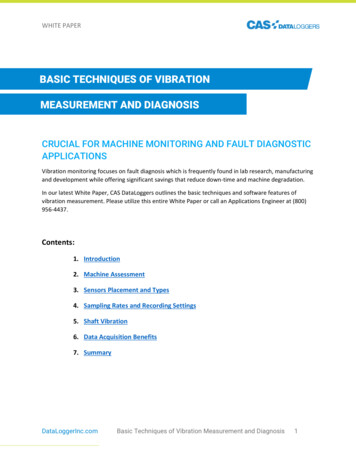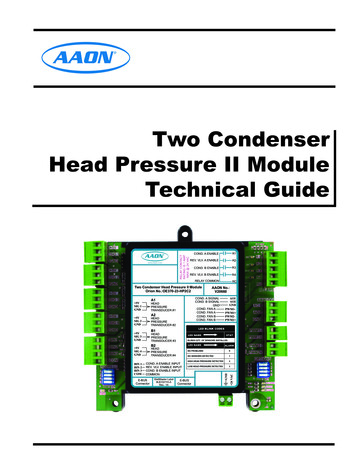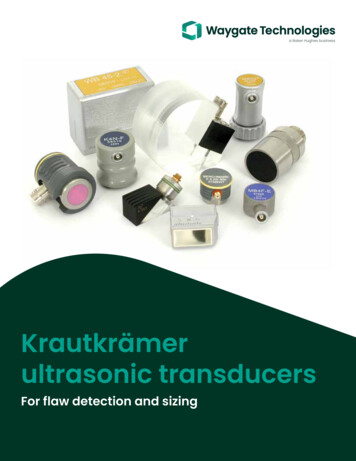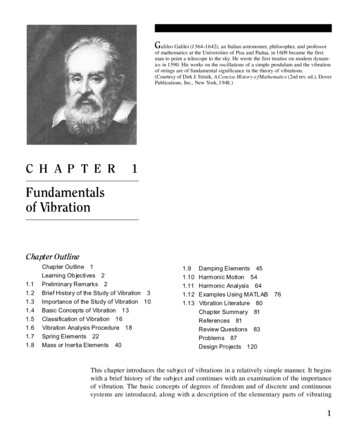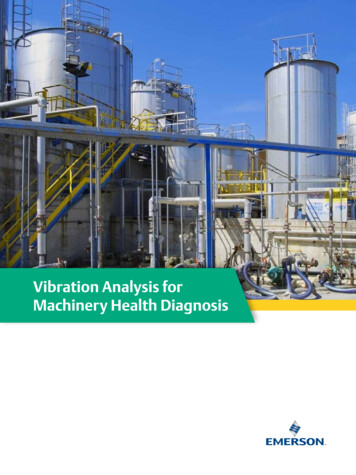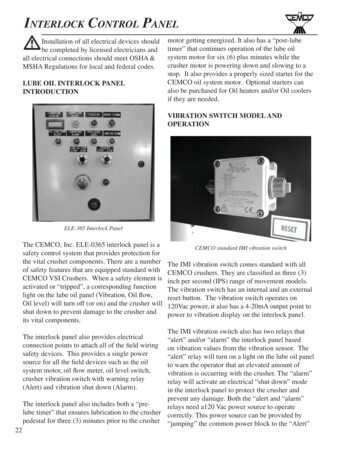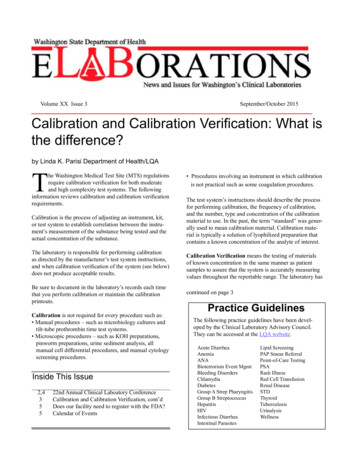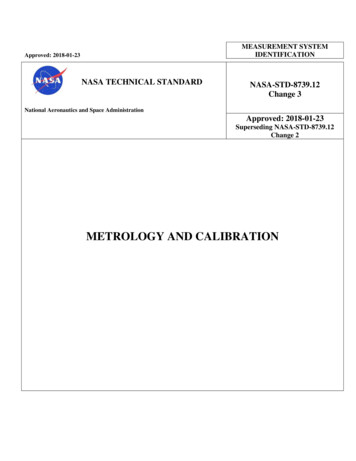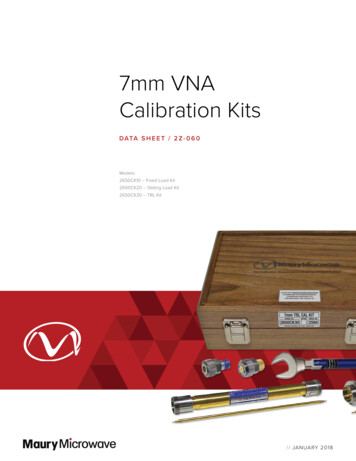
Transcription
PRODUCT DATAVibration Transducer Calibration System Type 3629Vibration Transducer Calibration System Type 3629 is aneasy-to-use, automatic vibration calibration system that providestraceable calibration of a wide range of transducers. The centralhardware for the basic system consists of a LAN-XI front end,which provides the necessary input channels and generatoroutput, a power amplifier, BK Connect analysis software and avibration exciter.Type 3629 systems are available in standard configurationsthat include all relevant software licences, cables, connectors,and accessories.Uses Comparison calibration of vibration transducers according toISO 16063-21:2005 – magnitude and phase Primary calibration of vibration transducers according toISO 16063-11:1999, Method 3 – magnitude and phase Calibration of vibration calibrators according toISO 16063-44:2016 – level, distortion and frequency Calibration of DC sensitivity by use of earth’s gravitationaccording to ISO 16063-16:2014 Calibration of conditioning amplifiers – gain and phase Calibration of vibration meters – vibration level linearity atselected frequencies, velocity and acceleration Calibration at high excitation levels 1 km/s –2 to 10 km/s –2,using a pneumatically operated projectile (POP) – suitable forshock transducers used in automotive/aerospace according toISO 16063-22:2005 Supervision of measuring instrumentation according toISO 9000 Quality assurance of sensors in manufacturing or useFeaturesEase of use Intuitive software user interface that does not requireprevious experience Comprehensive Microsoft SQL database:– Stores all pertinent data for the user's transducers, all datarequired for calibration, plus a history of all calibrations foreach transducer. With this data, the entire setup andcalibration procedure is made simple through automation– Provides possibility to share and use any selected equipmentwithin a multisystem setup running the same database Quick and easy display of results (pass/fail determination),and automatic storage to any user-defined drive ISO 17025:2017-compatible certificates that can becustomized and printedwww.bksv.com/calibration-systemsAccuracy Automated calibration of the front end that provides extremelyhigh calibration accuracy. Correction factors are stored in thedatabase for subsequent use and traceability Individual system frequency response characteristics arestored in the database, minimising calibration uncertaintiesand calibration time by correcting for such characteristicsSecurityAbility to set multiple user levels with defined access rights formaximum system securityProduct Data BP 1975 – 17
Flexibility Flexible configuration to support the full frequency range:– Calibrations from 0.1 Hz – 20 kHz– Frequency response testing from 40 Hz – 50 kHz Calibrates practically all transducer types: charge, CCLD,piezoresistive, variable capacitance, voltage, servo andelectrodynamic (for example, velocity pick-ups) Virtually any electrodynamic vibration exciter can be added PC processing power not critical to software performance Selection between SI or imperial units Complete standard systems include the necessary hardwareto fit your specific application and needs Multiple excitation methods:– Random excitation – for fast measurement speed and realtime frequency response information– Sine excitation – to concentrate the energy for lowfrequency calibrations and to satisfy special requirements– Swept-sine excitation – for fast measurement speed usingan SSR analyzerSystem DescriptionFig. 1 Basic system and workflowCer ficatesISODatabaseLAN-XI Data Acquisi on Modulewith Generatorand 2 Input ChannelsCharge to CCLDConverterLAN(when using standard referencetransducer Type 8305-001)DUTWorking StandardTransducerPC withVibra on TransducerCalibra on So warePowerOutputPower AmplifierThe basic Vibration Transducer Calibration System consists of aLAN-XI front end, which provides the necessary inputs andgenerator output, a power amplifier and an exciter. The front endis connected via network to a standard PC. A calibrated referenceor a calibrated working standard using working standardspectrum is used during calibration. With charge andpiezoresistive transducers, a suitable preamplifier must beincluded. With CCLD transducers (constant current line drivetransducers, known as IEPE, DeltaTron , ISOTRON and ICP ) orvoltage output types, no preamplifier is needed.There are a couple of standard reference transducers available: Type 8305-001: Used in the mid/high-frequency range Type 4575-D-001: Used in the low-frequency rangeFor piezoresistive and other bridge type transducers, DifferentialAmplifier Type 2697 is used for powering and conditioningthrough the LAN-XI front end. Type 2697 can also be used forVibra on Exciter190065/1powering variable capacitance and other transducers and can beconfigured with different excitation voltages.The system software, Vibration Transducer Calibration SoftwareType 5308, runs on the PC with no external processing, whichmeans that software performance increases in line with the PC.The operating system is Microsoft Windows , which provides youwith a familiar user interface, and a Microsoft SQL database, whichis accessed transparently by the system, is used for the storageand organization of data. The database also provides possibilityto share and use any selected equipment for multiple systems.Virtually any electrodynamic vibration exciter can be addedcovering the desired frequency range, excitation level andrequired payload.See the Ordering Information for a complete overview of standardsystem configurations. Note that any system can be customizedto fit special requirements.CalibrationThe system measures the FFT auto-spectra and cross-spectrabetween the transducer signals and calculates the frequencyresponse function. This removes nearly all influence fromdistortion and noise outside the single FFT band in which themeasurement is made. Very narrow bandwidths are used for thelow-frequency measurements, to minimise influence andcontribution of noise on measurement results.For the highest measurement speed and real-time frequencyresponse information, random excitation is used, while sineexcitation is used mainly to concentrate the energy for lowfrequency calibrations and to satisfy special requirements.2Depending on the system configuration and type of calibrationand uncertainty of measurement result needed, Type 3629 canperform direct comparison to calibrated reference standardaccelerometers, comparison by substitution using calibratedworking standard accelerometers and reference spectrum, orabsolute calibrations on virtually any type of vibration transducer.Calibrations based on the comparison method determine DUTcharacteristics by comparison to either a working standard or areference standard accelerometer usually calibrated at a nationalmetrology institute, for example, DPLA (Danish PrimaryLaboratory of Acoustics).www.bksv.com/calibration-systems
Back-to-back Calibration by SubstitutionThe sensitivities of two transducers can be compared by usingrandom excitation and the FFT analysis capability of the systemto measure the ratio of their outputs. By supplying the output fromthe reference standard accelerometer Input 1, and the output fromthe DUT to Input 2, the sensitivity of the DUT can be displayed asthe frequency response function (magnitude and phase).However, accuracy and ease of use can be improved byemploying the back-to-back calibration method, using the wellestablished calibration by substitution technique.This involves making two measurements:1. The transfer function between the working standardtransducer and the reference standard transducer ismeasured and stored for subsequent use over a specifiedtime. (This can be considered an extended transfer calibrationand is normally referred to as a reference spectrum)2. The transfer function between the DUT and the workingstandard is measured, the resulting frequency response iscalculated using the reference spectrum and the result isstored. The working standard remains fixed to the exciter headThe method offers the following advantages: Fast calibration, typically 50 seconds, with real-timefrequency response information by use of random excitation Cancellation of systematic errors contributed by theelectronics and dynamic properties Coverage of all frequencies in the range, effectively catchingpossible glitches Coverage of a dynamic range dependent upon the exciter Use of coherence to check linearity System availability during recalibration of referencestandard transducers Extremely high accuracy of FFT calibration technique using thesubstitution method and correction afterTo further improve the accuracy of the system, an automatedcalibration of all ranges in level and frequencies of the front endcan be performed using a high-precision voltmeter together withappropriate IEEE 488.2 interface or network for the PC*.Correction factors are stored in the database for subsequent useand traceability.Primary CalibrationAbsolute calibrations are performed using a laser interferometerwith quadrature output and a routine to convert these outputs tothe absolute displacement value as a function of time. Thismeans that measurements are based on the absolute parametersof time and the wavelength of light from a helium-neon laserfollowing ISO 16063-11:1999, Method 3 (sine approximation).Type 3629 can operate in the frequency range determined by thecapabilities of the exciter and transducers used. Where signalconditioning is needed (for example, for piezoelectrictransducers), the software is able to measure and store thefrequency response characteristics of the conditioners, and thencompensate for these characteristics during operation. Similarly,the controller is designed to characterize and drive virtually anyvibration source, and to use any reference transducer, with orwithout the use of a conditioning amplifier.Calibration of DC sensitivity of vibration transducers with DCresponse such as piezoresistive, variable capacitance, and servoaccelerometer types is done according to ISO 16063-16:2014.This is a primary calibration method by use of earth's gravitation.* The front end can also be sent to HBK to be calibrated. It will be returned with newupdated calibration data.Compliance with StandardsThe CE marking is the manufacturer's declaration that the product meets the requirements of the applicable EUdirectives.RCM mark indicates compliance with applicable ACMA technical standards – that is, for EMC and EME in Australia.China RoHS mark indicates compliance with administrative measures on the control of pollution caused by electronicinformation products according to the Ministry of Information Industries of the People’s Republic of ChinaWEEE mark indicates compliance with the EU WEEE Directive.SafetyEN/IEC 61010-1: Safety requirements for electrical equipment for measurement, control and laboratory use.ANSI/UL 61010-1: Safety requirements for electrical equipment for measurement, control and laboratory use.IEC 60204-1/EN 60204-1: Safety of machinery – Electrical equipment of machines – Part 1: General requirements.EMCEN/IEC 61326: Electrical equipment for measurement, control and laboratory use – EMC requirements.EMC EmissionEN/IEC 61000-6-3: Generic emission standard for residential, commercial and light industrial environments.EN/IEC 61000-6-4: Generic emission standard for industrial environments.CISPR 32: Radio disturbance characteristics of information technology equipment. Class B Limits.FCC Rules, Part 15: Complies with the limits for a Class B digital device.This ISM device complies with Canadian ICES-001 (standard for interference-causing equipment).EMC ImmunityEN/IEC 61000-6-1: Generic standards – Immunity for residential, commercial and light industrial environments.EN/IEC 61000-6-2: Generic standards – Immunity for industrial environments.NOTE: The above is only guaranteed using accessories listed in this document.TemperatureIEC 60068-2-1 & IEC 60068-2-2: Environmental Testing. Cold and Dry Heat.Operating Temperature: 5 to 40 C ( 41 to 104 F).Storage Temperature: –25 to 70 C (–13 to 158 F).HumidityOnly with LAN-XI Type 3160-A-042 module:IEC 60068-2-78: Environmental Testing. Damp Heat 40 C, 93% RH for 96 hours.MechanicalNon-operating. Only with LAN-XI Type 3160-A-042 module:IEC 60068-2-6: Vibration: 0.3 mm, 20 m/s2, 10 – 500 HzIEC 60068-2-27: Shock: 1000 m/s2IEC 60068-2-29: Bump: 1000 bumps at 250 m/s2www.bksv.com/calibration-systems3
SpecificationsStandard Configuration OverviewNOTE: The following specifications are typical. Individual specificationsdepend on the exciter, transducers and setup usedType 3629 systems are available in standard configurations that includeall relevant software licences, cables, connectors, and accessories.On delivery, systems are validated and fully operational and a fullindividual system validation report is produced and attachedINPUTCharge: 0.004 to 400 pC/ms –2 (0.04 to 4000 pC/g)(at 10 ms –2)Voltage: 0.004 to 400 mV/ms –2 (0.04 to 4000 mV/g)(at 10 ms –2)Velocity: 0.4 to 99 mV/mms –1 (10 to 2500 mV/in/s)Noise (Device Under Test Channel): Charge Input 4 10 –4 pC/Hz0.5 (above 10 Hz) withCharge-to-CCLD Converter Type 2647 Charge Input 2 10 –4 pC/Hz0.5 (above 10 Hz) withCharge-to-CCLD Converter Type 2647-B Charge Input 0.5 10 –4 pC/Hz0.5 (above 10 Hz) withNEXUS Conditioning Amplifier Type 2692INPUTIMPEDANCEVoltage: 1 MΩVelocity: 1 MΩFREQUENCYRANGEAccelerometers: Calibration: 0.1 Hz to 20 kHz Frequency response testing: 10 Hz to 50 kHzVelocity Pick-ups: 5 Hz to 10 kHzAll systems are pre-installed and come with: Standard Dell tower PC, running Windows with Microsoft Office Pro Dell PC monitor (25 LCD, 2560 1440 at 60 Hz, flat panel, colour)TYPE NO.FUNCTIONS AND FEATURESComparison calibration of vibrationtransducers according to ISO 1606321:2005 – acceleration, velocity ordisplacement3629B3629C3629D Calibration of conditioning amplifiers –gain and phase MAXIMUMTRANSDUCERPAYLOAD0.1 to 200 Hz: 11 kg, using APS 129 ELECTRO-SEIS LongStroke Shaker*5 Hz to 10 kHz: 2000 g, using Vibration Exciter Type 480810 Hz to 20 kHz: 500 g, using Vibration Exciter Type 480910 Hz to 50 kHz: 100 g, using Mini-shaker Type 4810CALIBRATIONACCURACYEstimated errors (using k 2 and including temperature andtransverse sensitivity effects) as per ISO 16063-21:2005: 1.0% @ 0.1 to 0.5 Hz 0.8% @ 0.5 to 10 Hz 0.6% @ 10 to 2000 Hz 0.8% @ 2000 to 5000 Hz 1.0% @ 5000 to 8000 Hz 1.2% @ 8000 to 10,000 Hz 1.5% @ 10,000 to 16,000 Hz 2.5% @ 16,000 to 20,000 HzEstimated errors (using k 2 and including temperature andtransverse sensitivity effects) as per ISO 16063-11:1999,Method 3: 0.5% @ 0.1 to 0.5 Hz 0.4% @ 0.5 to 5000 Hz 0.6% @ 5000 to 10,000 Hz 0.8% @ 10,000 to 12,500 Hz 1.2% @ 12,500 to 16,000 Hz 2.0% @ 16,000 to 20,000 HzCalibration of vibration meters – vibrationlevel linearity at selected frequencies,velocity and acceleration Calibration of force transducers(using 2 or more calibrated weights fromWeight Set UA-2228) Low-frequency vibration exciter(0.1 Hz – 200 Hz) Mid-frequency vibration exciter(5 Hz – 10 kHz) High-frequency vibration exciter(10 Hz – 20 kHz) Resonance curve testing(40 Hz – 50 kHz) Maximum payload of 11 kg(0.1 Hz – 200 Hz) Differential amplifier and break-out forpiezoresistive and bridge types DC calibration as per ISO 16063-16:2014 Microsoft SQL Maximum payload of 2000 g(5 Hz – 10 kHz)GENERATEDCERTIFICATESISO 17025:2017-compatible certificates available forgeneration in Microsoft WordMaximum payload of 500 g(10 Hz – 20 kHz) Calibration according to ISO 16063-21:2005 Measurement of bias voltage on CCLDaccelerometers and offset on DC typeaccelerometers Reference Standard AccelerometerType 8305-001(incl. DPLA primary accredited calibration) Reference Standard AccelerometerType 4575-D-001(incl. DPLA primary accredited calibration)4 Calibration of vibration calibratorsaccording to ISO 16063-44:2016 – level,distortion and frequencyDATABASE* Manufactured by APS Dynamics, Inc.3629A Precision reference capacitor forconditioner calibration (incl. 1 nF,accredited calibration) Calibration Weight Set UA-2228(incl. traceable factory calibration) TEDS transducer support(IEEE 1451.4, versions 0.9 and 1.0) Linearity calibration at selected frequency www.bksv.com/calibration-systems
Ordering InformationCalibration systems, along with any optional extensions, are only delivered as complete, ready-to-use systems with Microsoft Office Professionaland calibration software installed on the PC. Therefore, an order for a calibration system must include all the components of a complete system:hardware, software, software support, on-site training and installation services. Type 3629 systems have a two-year warranty that is valid from thedelivery of the product. An extended warranty is optional.VIBRATION CALIBRATION SYSTEM TYPE 3629-AHardware:Type 3629-A-001 Hardware for calibration in frequency range of10 Hz to 20 kHzSoftware:Type 5308-NVibration Transducer Calibration SoftwareSoftware Maintenance Contracts:M1-5308-NMaintenance Contract for Type 5308-N softwareExtended Warranty:3629-A-EW1Extended Warranty for Type 3629-A, 1-yearextension after standard warrantyVIBRATION CALIBRATION SYSTEM TYPE 3629-CHardware:Type 3629-C-001 Hardware for calibration in frequency range of0.1 Hz to 200 HzSoftware:Type 5308-NVibration Transducer Calibration SoftwareSoftware Maintenance Contracts:M1-5308-NMaintenance Contract for Type 5308-N softwareExtended Warranty:3629-C-EW1Extended Warranty for Type 3629-C, 1-yearextension after standard warrantyVIBRATION CALIBRATION SYSTEM TYPE 3629-BHardware:Type 3629-B-001 Hardware for calibration in frequency range of 5 Hzto 10 kHzSoftware:Type 5308-NVibration Transducer Calibration SoftwareSoftware Maintenance Contracts:M1-5308-NMaintenance Contract for Type 5308-N softwareExtended Warranty:3629-B-EW1Extended Warranty for Type 3629-B, 1-yearextension after standard warrantyVIBRATION CALIBRATION SYSTEM TYPE 3629-DCalibration of vibration calibrators including calibrated weight sets.Calibration of conditioning amplifiers including calibrated precisionreference capacitorHardware:Type 3629-D-001 Hardware for calibration in frequency range of0.1 Hz to 20 kHz (up to 50 kHz for frequencyresponse test)Software:Type 5308-NVibration Transducer Calibration SoftwareType 5312-NConditioning Amplifier Calibration SoftwareSoftware Maintenance Contracts:M1-5308-NMaintenance Contract for Type 5308-N softwareM1-5312-NMaintenance Contract for Type 5312-N softwareExtended Warranty:3629-D-EW1Extended Warranty for Type 3629-D, 1-yearextension after standard warrantywww.bksv.com/calibration-systems5
Hottinger Brüel&Kjær A/S. All rights reserved.2022-06BP 1975 – 17Teknikerbyen 28 · DK-2830 Virum · DenmarkTelephone: 45 77 41 20 00 · Fax: 45 45 80 14 05www.bksv.com · info@hbkworld.comLocal representatives and service organizations worldwideTo learn more about all HBK offerings, please visit hbkworld.comAlthough reasonable care has been taken to ensure the information inthis document is accurate, nothing herein can be construed to implyrepresentation or warranty as to its accuracy, currency orcompleteness, nor is it intended to form the basis of any contract.Content is subject to change without notice – contact HBK for thelatest version of this document.Brüel & Kjær and all other trademarks, service marks, trade names,logos and product names are the property of Hottinger Brüel & Kjær A/Sor a third-party company.
ISO 16063-21:2005 - magnitude and phase Primary calibration of vibration transducers according to ISO 16063-11:1999, Method 3 - magnitude and phase Calibration of vibration calibrators according to ISO 16063-44:2016 - level, distortion and frequency Calibration of DC sensitivity by use of earth's gravitation
